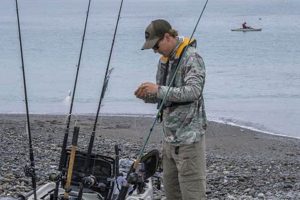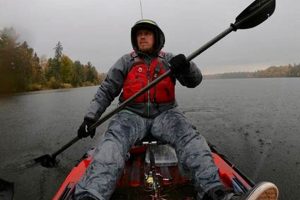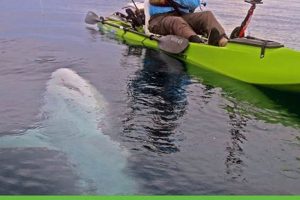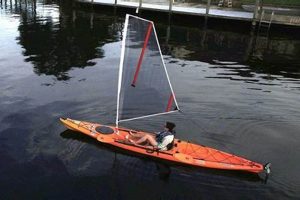Recreational fishing from standard, non-specialized kayaks is a readily accessible activity. A typical kayak, often used for leisurely paddling, can be adapted for angling with readily available equipment and minimal modifications. For example, rod holders can be easily mounted, and tackle storage solutions are readily available.
Utilizing standard kayaks for fishing offers a cost-effective entry point into kayak angling, allowing individuals to explore this popular pastime without the immediate investment in a specialized fishing kayak. This approach allows anglers to access shallower waters and navigate tight spaces often inaccessible to larger motorized boats, enhancing fishing opportunities and providing a closer connection to nature. The historical precedent of using small, maneuverable watercraft for fishing underscores the practicality and enduring appeal of this method.
This practicality extends to various aspects of kayak fishing, including equipment selection, launching techniques, and safety considerations, all of which will be explored further.
Tips for Fishing from a Standard Kayak
Preparation and awareness are crucial for a successful and safe fishing experience from a standard kayak. The following tips offer guidance for maximizing enjoyment and minimizing potential challenges.
Tip 1: Prioritize Stability: Consider kayak width and hull design. Wider, flatter hulls generally offer greater stability, particularly for beginners. Beginners should practice entering, exiting, and maneuvering the kayak before adding fishing gear.
Tip 2: Distribute Weight Evenly: Proper weight distribution is essential for maintaining balance and preventing capsizing. Distribute gear evenly within the kayak, avoiding excessive weight at either end.
Tip 3: Secure Gear Properly: Utilize appropriate storage solutions such as dry bags and tackle boxes to organize and secure equipment. This prevents gear loss and ensures accessibility.
Tip 4: Choose Suitable Paddles: Select paddles appropriate for the kayak’s width and the user’s physical characteristics. A properly sized paddle enhances efficiency and reduces fatigue.
Tip 5: Plan for Water Conditions: Assess weather forecasts, tides, and currents before embarking. Avoid fishing in strong winds, rough waters, or hazardous conditions.
Tip 6: Wear a Personal Flotation Device (PFD): A PFD is essential safety equipment and should be worn at all times while on the water.
Tip 7: Inform Someone of Your Plans: Always share your fishing location and estimated return time with a responsible individual.
Tip 8: Practice Catch and Release Techniques: Promote conservation by employing proper catch and release practices to minimize stress on fish populations.
Adherence to these guidelines will enhance safety and increase the likelihood of a productive and enjoyable fishing experience. Careful planning and a focus on safety contribute significantly to a positive outcome on the water.
By understanding these fundamental principles, individuals can confidently and responsibly enjoy the unique experience of fishing from a standard kayak.
1. Kayak Stability
Kayak stability plays a critical role in determining the feasibility and safety of fishing from a standard kayak. A stable platform is essential for various fishing activities, including casting, reeling, and landing fish. Instability can lead to difficulties in maintaining balance, hindering accurate casting and increasing the risk of capsizing, especially when handling active fish. For example, the sudden movement of a hooked fish can destabilize a narrow or tippy kayak, potentially resulting in gear loss or even personal injury. Conversely, a stable kayak provides a secure platform, allowing anglers to focus on fishing rather than maintaining balance.
Several factors influence kayak stability, including hull design, width, and weight distribution. Wider, flatter hulls generally offer greater primary stability, making them more resistant to initial tipping. However, they may be less maneuverable. Longer, narrower kayaks tend to track better but can be more susceptible to tipping. Proper weight distribution within the kayak is also crucial for maintaining stability. Uneven weight distribution can create instability, increasing the likelihood of capsizing. For instance, concentrating weight at the stern can cause the bow to rise, making the kayak more susceptible to wind and waves.
Understanding the relationship between kayak stability and fishing success is paramount. Anglers should carefully consider their kayak’s stability characteristics in relation to their intended fishing environment and target species. Selecting a kayak with appropriate stability for the intended fishing conditions significantly contributes to a safer and more enjoyable experience. Prioritizing stability also allows anglers to utilize a wider range of fishing techniques and handle larger fish more effectively. Ultimately, recognizing the importance of kayak stability enhances safety, improves fishing performance, and promotes a more confident and enjoyable experience on the water.
2. Gear Storage
Gear storage is a critical factor influencing the practicality and success of fishing from a standard kayak. Limited storage capacity necessitates careful consideration of essential equipment and efficient organization. Insufficient or poorly organized storage can lead to tangled lines, lost tackle, and compromised safety. For example, loose hooks or lures can snag on clothing or the kayak itself, creating hazardous situations. Conversely, well-planned gear storage allows for quick access to necessary items, maximizing fishing time and minimizing disruptions.
Several strategies can optimize gear storage in a standard kayak. Utilizing waterproof bags and containers protects equipment from water damage and keeps items organized. Small tackle boxes or trays can be secured within the cockpit for easy access to frequently used lures and tools. Rod holders, either mounted or freestanding, keep rods secure and readily available. Leashes attached to essential items prevent loss overboard. Prioritizing lightweight and compact gear minimizes bulk and maximizes available space. For instance, collapsible fishing nets and multi-purpose tools save valuable space and weight. Efficient packing and securing gear before launching ensures a balanced and stable kayak, further enhancing safety and performance.
Effective gear storage directly impacts fishing efficiency and safety. A well-organized system allows anglers to focus on fishing rather than managing equipment. Proper storage also minimizes the risk of entanglement or loss, contributing to a safer and more productive experience. Understanding the constraints and opportunities related to gear storage in a standard kayak enables anglers to make informed decisions about equipment choices and organizational strategies, ultimately maximizing their time and success on the water.
3. Accessibility of Water
Accessibility of water significantly influences the practicality and appeal of fishing from a standard kayak. Kayaks offer distinct advantages in reaching locations often inaccessible to larger motorized boats, expanding fishing opportunities and providing a closer connection to the aquatic environment. Evaluating launch points, navigable waterways, and specific fishing spots is essential for maximizing the benefits of kayak fishing.
- Launch Sites:
Kayaks require minimal infrastructure for launching, allowing access to diverse environments. Small boat ramps, unimproved shorelines, and even shallow wading areas can serve as launch points. This versatility opens up a wide range of fishing locations, from secluded ponds and small streams to larger lakes and coastal estuaries. For instance, a kayak can easily be launched from a sandy beach inaccessible to a trailered boat, providing access to near-shore reefs or shallow flats. The availability and suitability of launch sites directly influence the range of fishing opportunities accessible by kayak.
- Navigable Waterways:
Kayaks excel in navigating shallow water and confined spaces, allowing anglers to reach areas often beyond the reach of larger vessels. Navigating shallow creeks, maneuvering through dense vegetation, and accessing protected coves are all within the capabilities of a standard kayak. This maneuverability allows anglers to target specific habitats and fish species that may be difficult to reach by other means. For example, a kayak can silently navigate a narrow, winding creek, providing access to prime bass or panfish habitat. Understanding the navigable waterways within a given area expands fishing options and increases the potential for success.
- Fishing Spot Diversity:
Kayaks offer access to diverse fishing spots, including shallow flats, weed beds, submerged structures, and protected coves, often unavailable to larger boats. This expanded access allows anglers to target a variety of species and utilize diverse fishing techniques tailored to specific habitats. For instance, a kayak angler can easily position themselves near a submerged log or rock pile, a prime location for ambush predators. This ability to access diverse fishing spots significantly enhances the versatility and potential rewards of kayak fishing.
- Portage and Transportation:
The portability of standard kayaks expands access to remote or otherwise difficult-to-reach fishing locations. Kayaks can be easily transported on car roof racks, trailers, or even carried short distances, opening up fishing opportunities beyond the reach of larger, less portable boats. This portability allows anglers to explore secluded waters and access areas with limited or no boat launch facilities. For example, a kayak can be carried over a short land barrier to access a remote pond or lake, providing unique fishing opportunities. The ease of transport enhances the overall accessibility and appeal of kayak fishing.
Considering these accessibility factors is essential for maximizing the benefits of fishing from a standard kayak. The ability to launch from various locations, navigate diverse waterways, and access a wide range of fishing spots contributes significantly to the versatility and appeal of this fishing platform. Understanding these elements allows anglers to effectively plan trips and maximize their fishing success.
4. Fishing Techniques
Fishing techniques employed from a standard kayak require adaptation to the unique characteristics of this platform. Stability, maneuverability, and limited space influence tackle choices, casting methods, and fish-fighting strategies. Effective kayak angling necessitates adjustments to traditional techniques to maximize success and ensure safety.
- Casting Techniques:
Casting from a seated position in a kayak requires adjustments to maintain balance and accuracy. Underhand or sidearm casts are often preferred to overhead casts, minimizing the risk of tipping or entanglement. Practicing casting in a controlled environment before venturing onto the water is essential. For example, mastering a sidearm cast allows for accurate presentations under low-hanging branches or near shoreline structures. Adapting casting techniques to the kayak environment enhances both safety and fishing effectiveness.
- Tackle Selection:
Tackle selection is influenced by the target species, fishing environment, and the limitations of kayak fishing. Shorter rods and lighter tackle are often preferred for maneuverability within the confined space of a kayak. Selecting lures and terminal tackle appropriate for the target species and fishing location remains crucial. For instance, using lighter lines and smaller lures may be advantageous when targeting panfish in shallow, weedy areas. Adapting tackle choices to the specific constraints and opportunities of kayak fishing optimizes effectiveness.
- Fish Fighting Strategies:
Landing fish from a kayak requires careful consideration of balance and leverage. Maintaining a low center of gravity and using the kayak’s momentum can assist in controlling larger fish. Utilizing a landing net or lip grip facilitates safe and efficient retrieval. For example, keeping a hooked fish away from the kayak’s hull during the fight minimizes the risk of line entanglement or damage. Adapting fish-fighting strategies to the kayak environment ensures both angler safety and successful retrieval of the catch.
- Drift Fishing and Anchoring:
Controlling kayak movement while fishing is essential for presenting baits effectively and maintaining desired positions. Drift fishing allows anglers to cover water naturally, while anchoring stabilizes the kayak in specific locations. Understanding water currents and wind conditions is crucial for successful drift fishing. Using an appropriate anchor system prevents unwanted movement and maintains position near promising fishing areas. For example, employing a drift sock can slow the kayak’s drift in moving water, allowing for controlled presentations along a specific current seam. Adapting drift fishing or anchoring techniques based on environmental conditions enhances fishing success from a kayak.
Mastery of these adapted fishing techniques is crucial for successful kayak angling. Understanding the interplay between kayak characteristics and fishing strategies allows anglers to effectively target their desired species while prioritizing safety and efficiency. By adapting traditional techniques to the unique demands of the kayak environment, anglers can fully realize the potential of this versatile fishing platform.
5. Safety Precautions
Safety precautions are paramount when fishing from a standard kayak. The inherent risks associated with being on the water are amplified by the activities involved in fishing, such as casting, retrieving fish, and navigating various water conditions. Neglecting safety protocols can lead to serious consequences, including equipment loss, injury, or even fatalities. Therefore, a comprehensive understanding and consistent application of safety measures are essential for responsible kayak angling.
- Personal Flotation Devices (PFDs):
Wearing a properly fitted PFD is non-negotiable. PFDs provide essential buoyancy in the event of capsizing or accidental immersion, significantly increasing the chances of survival. Choosing a PFD specifically designed for paddling offers enhanced comfort and mobility while fishing. For example, inflatable PFDs allow for a greater range of motion during casting and reeling. Consistent PFD use is fundamental to safe kayak fishing.
- Weather Awareness:
Checking weather forecasts before embarking on a kayak fishing trip is critical. Sudden changes in weather, such as strong winds or thunderstorms, can create hazardous conditions on the water. Being aware of potential weather changes allows anglers to make informed decisions about launching or returning to shore. For example, strong offshore winds can quickly push a kayak far from the shoreline, making it difficult to return. Prioritizing weather awareness mitigates risks associated with changing conditions.
- Communication Devices:
Carrying a reliable communication device, such as a waterproof cell phone or VHF radio, enables communication in emergencies. Informing someone on shore of planned fishing locations and estimated return times is also essential. This allows for prompt assistance if an angler fails to return as scheduled. For instance, a cell phone in a waterproof case can be used to contact emergency services in the event of capsizing or injury. Maintaining communication capabilities enhances safety and facilitates rapid response in emergencies.
- Navigation and Lighting:
Carrying navigational tools, such as a compass or GPS device, aids in maintaining orientation, especially in unfamiliar waters or during low visibility conditions. Carrying a waterproof flashlight or headlamp provides illumination in low-light situations or during unexpected delays. For example, a GPS device can assist in navigating back to the launch point in fog or darkness. Adequate navigation and lighting equipment enhance safety and reduce the risk of disorientation.
Adhering to these safety precautions is fundamental to responsible kayak fishing. These measures mitigate inherent risks and contribute significantly to a safe and enjoyable experience. Prioritizing safety not only protects anglers from potential harm but also allows for a more focused and productive fishing experience, fostering a deeper appreciation for the sport and the environment.
6. Legal Regulations
Legal regulations govern all aspects of recreational fishing, including fishing from a standard kayak. Compliance with these regulations is essential for responsible angling and resource conservation. Ignoring legal requirements can result in fines, penalties, and suspension of fishing privileges. Understanding and adhering to applicable regulations ensures the sustainability of fish populations and the continued enjoyment of the sport.
- Fishing Licenses and Permits:
Most jurisdictions require anglers to possess valid fishing licenses and, in some cases, specific permits for certain species or bodies of water. Regulations regarding license types, fees, and permitted fishing methods vary by location. For example, saltwater fishing may require a different license than freshwater fishing, and certain protected species may require special permits. Obtaining the necessary licenses and permits before launching a kayak ensures compliance with local regulations.
- Size and Catch Limits:
Regulations often dictate minimum and maximum size limits for specific fish species, as well as daily catch limits. These regulations help maintain healthy fish populations by protecting juveniles and ensuring adequate breeding stock. For example, regulations may specify a minimum size limit for bass, requiring anglers to release fish below that size. Adhering to size and catch limits contributes to the long-term sustainability of fisheries.
- Closed Seasons and Areas:
Specific seasons or areas may be closed to fishing to protect vulnerable fish populations during spawning periods or in sensitive habitats. Regulations may also restrict fishing access to certain areas, such as protected reserves or designated spawning grounds. For example, fishing may be prohibited in a particular river section during salmon spawning season. Respecting closed seasons and areas helps protect fish populations and preserve critical habitats.
- Equipment Restrictions:
Regulations may restrict the type of fishing gear permitted, such as prohibiting certain types of nets or limiting the number of hooks per line. These restrictions aim to prevent overfishing and minimize the impact on non-target species. For example, using live bait may be prohibited in certain areas to prevent the introduction of invasive species. Adhering to equipment restrictions ensures compliance and contributes to responsible fishing practices.
Understanding and adhering to all applicable fishing regulations is an integral part of responsible kayak angling. Compliance safeguards fish populations, protects aquatic environments, and ensures the continued enjoyment of the sport. By prioritizing legal compliance, kayak anglers contribute to the sustainability of fisheries and the preservation of natural resources for future generations. Checking local regulations before each fishing trip ensures awareness of any changes or specific requirements for the intended fishing location.
Frequently Asked Questions
This section addresses common inquiries regarding the use of standard kayaks for fishing.
Question 1: What are the primary stability concerns when fishing from a standard kayak?
Standard kayaks, designed primarily for recreational paddling, may exhibit less stability than specialized fishing kayaks. Width, hull design, and weight distribution significantly influence stability. Anglers should prioritize kayaks with wider, flatter hulls for increased stability, especially when casting, reeling, or landing fish. Proper weight distribution is crucial to prevent tipping.
Question 2: How much gear can a standard kayak realistically accommodate for fishing?
Storage capacity in standard kayaks is limited. Prioritizing essential gear and employing efficient organization strategies are crucial. Waterproof bags, tackle boxes, and mounted rod holders maximize space utilization. Minimizing gear and opting for compact, multi-purpose tools enhances efficiency.
Question 3: Are there specific water types better suited for fishing from a standard kayak?
Standard kayaks excel in calm, protected waters such as ponds, lakes, slow-moving rivers, and sheltered coastal areas. Rough waters, strong currents, and open ocean conditions pose significant safety risks and should be avoided. Careful assessment of water conditions prior to launching is essential.
Question 4: What are the essential safety precautions for fishing from a standard kayak?
Wearing a Personal Flotation Device (PFD) is paramount. Checking weather forecasts, carrying communication devices, and informing someone of fishing plans are crucial safety measures. Carrying navigation tools and lighting equipment further enhances safety, particularly in low-light conditions or unfamiliar waters.
Question 5: What are the common legal restrictions one should be aware of when kayak fishing?
Regulations vary by jurisdiction but typically include fishing licenses, size and catch limits, closed seasons and areas, and equipment restrictions. Anglers must research and adhere to local regulations before fishing from a kayak. Ignorance of regulations does not exempt individuals from penalties.
Question 6: What are the advantages of using a standard kayak for fishing compared to shore fishing?
Kayaks provide enhanced access to fishing locations unreachable from shore, allowing anglers to target specific habitats and species. They offer increased mobility and the ability to cover more water. Kayaks also provide a stable platform for casting and fighting fish compared to wading or standing on uneven shorelines.
Careful consideration of these frequently asked questions enhances preparedness and contributes to a safer and more rewarding kayak fishing experience.
Beyond these FAQs, numerous resources offer further guidance on safe and effective kayak fishing practices. Consult local fishing organizations, outfitters, and online communities for additional information.
Conclusion
The feasibility of fishing from a standard kayak hinges on understanding key factors such as stability, gear storage, water accessibility, appropriate fishing techniques, essential safety precautions, and adherence to legal regulations. While standard kayaks offer a cost-effective entry point into kayak angling, their limitations necessitate careful planning and adaptation. Prioritizing stability, efficiently organizing gear, and selecting suitable fishing locations enhance the experience. Adapting fishing techniques to the kayak’s constraints, and prioritizing safety through proper equipment and responsible practices are crucial for a successful and safe outing. Adhering to all legal regulations ensures the sustainability of this enjoyable pastime.
Ultimately, informed decision-making and responsible practices transform the question “can you fish from a regular kayak?” into a confident affirmation. Embracing these considerations allows individuals to experience the unique rewards and challenges of kayak angling, fostering a deeper connection with the aquatic environment and promoting responsible stewardship of natural resources.






